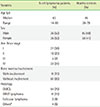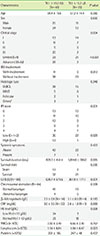Abstract
Background
The cell cycle-dependent enzyme thymidine kinase 1 (TK1) is known to increase during cancer cell proliferation and has been reported as a prognostic marker for various hematologic malignancies and solid tumors. This study aimed to determine the reference interval in Korean healthy controls and to evaluate the usefulness of TK1 as a biomarker for aggressive clinical behavior in B-cell lymphoma patients.
Methods
We enrolled 72 previously untreated patients with B-cell lymphoma and 143 healthy controls. Serum TK1 levels were measured by chemiluminescence immunoassay (Liaison®, DiaSorin, USA). We established the reference intervals in healthy controls. The diagnostic performance of serum TK1 was studied using receiver operating characteristic (ROC) analysis, and the correlation between the cutoff level for serum TK1 and clinical characteristics of B-cell lymphoma was evaluated.
Results
The reference range (95th percentile) of serum TK1 in healthy controls was 5.4-21.8 U/L. There was a clear difference in TK1 levels between patients with B-cell lymphoma and healthy controls (40.6±68.5 vs. 11.8±4.4 U/L, P<0.001). The area under the curve of serum TK1 for the diagnosis of B-cell lymphoma was 0.73 (cutoff, 15.2 U/L; sensitivity, 59.7%; specificity, 83.2%). An increased TK1 level (≥15.2 U/L) correlated with the advanced clinical stage (P<0.001), bone marrow involvement (P=0.013), international prognostic index score (P=0.001), lactate dehydrogenase level (P=0.001), low Hb level (<12 g/dL) (P=0.028), and lymphocyte count (P=0.023).
Figures and Tables
 | Fig. 1Comparison of serum thymidine kinase 1 (TK1) levels between healthy controls and patients with B-cell lymphoma. The upper and lower ends of the boxes and the box inner lines correspond to the 3rd and 1st quartiles and median values, respectively. Error bars denote minimum and maximum values, and circles and stars indicate outlier values. |
 | Fig. 2Receiver operating characteristic (ROC) curve of serum thymidine kinase 1 (TK1) levels in patients with B-cell lymphoma. The area under the curve (AUC) of serum TK1 for the diagnosis of B-cell lymphoma was 0.73 (cutoff, 15.2 U/L) with its 95% confidence interval. |
Table 1
Baseline characteristics of healthy controls (N=143) and patients with B-cell lymphoma (N=72)

Table 2
Correlation between serum thymidine kinase 1 (TK1) levels and clinical characteristics of 72 patients with B-cell lymphoma

*Include small lymphocytic lymphoma, splenic B cell lymphoma, DLBCL associated with low-grade MALT lymphoma, and pediatric nodal marginal zone lymphoma.
Abbreviations: CRP, c-reactive protein; DLBCL, diffuse large B-cell lymphoma; Hb, hemoglobin; IPI, international prognosis index; LD, lactate dehydrogenase; MALT lymphoma, extranodal marginal zone lymphoma of mucosa-associated lymphoid tissue; WBCs, white blood cells.
References
1. Sherley JL, Kelly TJ. Regulation of human thymidine kinase during the cell cycle. J Biol Chem. 1988; 263:8350–8358.

2. Munch-Petersen B. Enzymatic regulation of cytosolic thymidine kinase 1 and mitochondrial thymidine kinase 2: a mini review. Nucleosides Nucleotides Nucleic Acids. 2010; 29:363–369.

3. Aufderklamm S, Todenhöfer T, Gakis G, Kruck S, Hennenlotter J, Stenzl A, et al. Thymidine kinase and cancer monitoring. Cancer Lett. 2012; 316:6–10.

4. Gronowitz JS, Hagberg H, Källander CF, Simonsson B. The use of serum deoxythymidine kinase as a prognostic marker, and in the monitoring of patients with non-Hodgkin's lymphoma. Br J Cancer. 1983; 47:487–495.

5. Rehn S, Glimelius B, Sundström C. A comparative study of proliferation-associated parameters in B-cell non-Hodgkin lymphoma. Hematol Oncol. 1991; 9:287–298.

6. Hallek M, Emmerich B, Strohmeyer S, Busch R, Reichle A, Senekowitsch R. Activity of serum thymidine kinase in non-Hodgkin lymphoma: relationship to other prognostic factors. Klin Wochenschr. 1988; 66:718–723.

7. Hallek M, Wanders L, Strohmeyer S, Emmerieh B. Thymidine kinase: a tumor marker with prognostic value for non-Hodgkin's lymphoma and a broad range of potential clinical applications. Ann Hematol. 1992; 65:1–5.

8. Ellims PH, Eng Gan T, Medley G, Van Der Weyden MB. Prognostic relevance of thymidine kinase isozymes in adult non-Hodgkin's lymphoma. Blood. 1981; 58:926–930.

9. Pan ZL, Ji XY, Shi YM, Zhou J, He E, Skog S. Serum thymidine kinase 1 concentration as a prognostic factor of chemotherapy-treated non-Hodgkin's lymphoma patients. J Cancer Res Clin Oncol. 2010; 136:1193–1199.

10. Sadamori N, Ichiba M, Mine M, Hakariya S, Hayashibara T, Itoyama T, et al. Clinical significance of serum thymidine kinase in adult T-cell leukaemia and acute myeloid leukaemia. Br J Haematol. 1995; 90:100–105.

11. O'Neill KL, Buckwalter MR, Murray BK. Thymidine kinase: diagnostic and prognostic potential. Expert Rev Mol Diagn. 2001; 1:428–433.
12. Svobodova S, Topolcan O, Holubec L, Treska V, Sutnar A, Rupert K, et al. Prognostic importance of thymidine kinase in colorectal and breast cancer. Anticancer Res. 2007; 27:1907–1909.
13. O'Neill KL, Abram WP, McKenna PG. Serum thymidine kinase levels in cancer patients. Ir J Med Sci. 1986; 155:272–274.
14. The Korean Society of Hematology. Non-Hodgkin lymphoma. the Korean Society of Hematology. Hematology. 2nd ed. Seoul: PanMun;2011. p. 381–394.
15. Ke PY, Chang ZF. Mitotic degradation of human thymidine kinase 1 is dependent on the anaphase-promoting complex/cyclosome-CDH1-mediated pathway. Mol Cell Biol. 2004; 24:514–526.

16. Chen Y, Ying M, Chen Y, Hu M, Lin Y, Chen D, et al. Serum thymidine kinase 1 correlates to clinical stages and clinical reactions and monitors the outcome of therapy of 1,247 cancer patients in routine clinical settings. Int J Clin Oncol. 2010; 15:359–368.

17. Di Raimondo F, Giustolisi R, Lerner S, Cacciola E, O'Brien S, Kantarjian H, et al. Retrospective study of the prognostic role of serum thymidine kinase level in CLL patients with active disease treated with fludarabine. Ann Oncol. 2001; 12:621–625.

18. Konoplev SN, Fritsche HA, O'Brien S, Wierda WG, Keating MJ, Gornet TG, et al. High serum thymidine kinase 1 level predicts poorer survival in patients with chronic lymphocytic leukemia. Am J Clin Pathol. 2010; 134:472–477.

19. Szánthó E, Bhattoa HP, Csobán M, Antal-Szalmás P, Újfalusi A, Kappelmayer J, et al. Serum thymidine kinase activity: analytical performance, age-related reference ranges and validation in chronic lymphocytic leukemia. PLoS One. 2014; 9:e91647.





 PDF
PDF ePub
ePub Citation
Citation Print
Print


 XML Download
XML Download